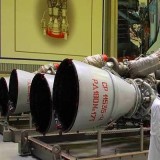US Air Force B-1B Lancer Bombers Deploy to Guam in Strategic Show of Force in Indo-Pacific Region

{loadposition bannertop}
{loadposition sidebarpub}
As part of a powerful show of U.S. military strength and strategic deterrence in the Indo-Pacific region, a U.S. Air Force Bomber Task Force (BTF) consisting of B-1B Lancer aircraft, airmen, and support equipment from the 34th Bomb Squadron at Ellsworth Air Force Base, South Dakota, arrived at Andersen Air Force Base, Guam, on January 15, 2025. This high-profile deployment is part of the U.S. Air Force’s ongoing efforts to strengthen its presence in the Indo-Pacific region, enhancing operational capabilities and cooperation with Allies and partners.Follow Army Recognition on Google News at this link
A U.S. Air Force B-1B Lancer from the 34th Expeditionary Bomb Squadron at Ellsworth Air Force Base, S.D., powers down the runway during Bomber Task Force 25-1 at Andersen Air Force Base, Guam, on January 21, 2025. (Picture source: U.S. DoD)
The U.S. Air Force B-1B Lancer bombers are deployed as part of Pacific Air Forces’ (PACAF) training exercises aimed at reinforcing the rules-based international order in the region. These missions not only demonstrate the versatility and readiness of the U.S. Air Force but also bolster strategic deterrence efforts in a key area of global geopolitics. With its vast and complex security challenges, the Indo-Pacific serves as a crucial theater for such operational exercises.
Given the growing security concerns arising from adversaries such as China and North Korea, the Indo-Pacific region is a focal point of U.S. military strategy. With its strategic location, Guam is an ideal hub for BTF operations, offering the U.S. Air Force the ability to project power and rapidly extend its operational reach. These deployments are about showcasing strength and ensuring U.S. forces’ interoperability with regional allies and partners. Pacific Air Forces’ Bomber Task Force operations involve multiple military units, including bombers, fighter jets, surveillance, and refueling aircraft, all integrated to provide a unified and potent force. Through these joint exercises, the U.S. aims to enhance coordination with its Allies, improve mutual capabilities, and deter potential threats. The deployment also supports the U.S.’s strategic priorities in ensuring freedom of navigation, protecting sea lanes, and maintaining stability in the face of growing military expansionism in the region.
The B-1B Lancer, a versatile strategic bomber, plays a crucial role in this Bomber Task Force deployment. Originally designed for high-speed, low-level penetration missions, the B-1B has evolved into a multi-role, long-range bomber capable of delivering a variety of conventional and nuclear weapons. Its operational flexibility and advanced technological features make it an indispensable asset in both peacetime deterrence and wartime operations.
The B-1B Lancer bomber aircraft can carry many munitions, including Joint Direct Attack Munitions (JDAMs), cruise missiles, and specialized munitions for specific strike missions. The B-1B’s variable-sweep wing design allows it to achieve speeds of Mach 1.2 at low altitudes, making it capable of evading enemy radar systems and striking with precision at a broad range of targets. Additionally, its large internal payload capacity allows it to carry up to 34,000 kg (75,000 pounds) of ordnance, which gives commanders tremendous flexibility in mission planning.
For the Indo-Pacific region, where long distances and complex terrain often challenge conventional airpower, the B-1B’s operational range and capabilities are particularly valuable. Its ability to rapidly deploy and integrate with fighter aircraft and other assets significantly enhances the United States’ ability to conduct extended operations across the vast expanse of the Indo-Pacific.
The B-1B Lancer’s most notable feature is its payload. Capable of carrying up to 34,000 kg (75,000 pounds) of ordnance, it can deliver a combination of bombs, missiles, and precision-guided munitions (PGMs). This flexibility enables the aircraft to conduct a wide array of missions, from strategic strikes to close-air support, with the ability to carry specialized munitions like the Joint Air-to-Surface Standoff Missile (JASSM).
Equipped with state-of-the-art avionics, the B-1B features advanced radar and electronic warfare systems. Its radar suite provides high-resolution terrain-following and radar mapping capabilities, which is crucial for low-level penetration missions. The aircraft’s sophisticated communications systems allow for secure, real-time coordination with ground and airborne forces, enhancing the effectiveness of joint operations with Allies and partners.
The B-1B Lancer is crewed by four personnel—a pilot, a co-pilot, and two weapons systems officers. Its operational range is approximately 9,260 km (5,000 nautical miles) with aerial refueling, ensuring that it can cover vast distances and remain on station for extended periods. In the Indo-Pacific context, this range allows the B-1B to operate effectively from forward bases like Guam and conduct long-range missions that might require significant operational reach.
While not a “stealth” aircraft in the same category as the B-2 or F-35, the B-1B’s ability to fly at low altitudes at high speeds offers a degree of survivability against conventional radar systems. The bomber is equipped with radar-absorbent coatings and other passive stealth features designed to reduce its radar signature, particularly during low-level ingress and egress phases of an attack.
The BTF deployment to the Indo-Pacific region also highlights the increasing importance of joint and allied operations in the modern defense environment. By integrating with U.S. Navy and Army components, along with forces from key regional Allies like Japan, South Korea, and Australia, the U.S. Air Force is enhancing the ability of its forces to conduct coordinated, large-scale operations. This strengthens the collective deterrent effect of allied forces in the region, sending a clear message of readiness to potential adversaries.
In addition to tactical operations, these exercises reinforce the broader strategic goals of the United States, including ensuring maritime security, maintaining freedom of navigation, and promoting a rules-based international order. The ability to conduct these operations in cooperation with regional partners ensures that the U.S. and its Allies are able to counter emerging threats and respond effectively to crises, whether they be military, economic, or diplomatic in nature.
The deployment of U.S. Air Force B-1B Lancer bomber aircraft to Guam as part of the Bomber Task Force demonstrates U.S. airpower and is a critical component in reinforcing the U.S.’s strategic position in the Indo-Pacific region. Through joint training exercises, interoperability, and strategic deterrence, the U.S. Air Force ensures its readiness to respond to any challenge in the region. With advanced capabilities like those of the B-1B Lancer, the U.S. maintains a formidable presence in one of the most geopolitically sensitive areas of the world.

{loadposition bannertop}
{loadposition sidebarpub}
As part of a powerful show of U.S. military strength and strategic deterrence in the Indo-Pacific region, a U.S. Air Force Bomber Task Force (BTF) consisting of B-1B Lancer aircraft, airmen, and support equipment from the 34th Bomb Squadron at Ellsworth Air Force Base, South Dakota, arrived at Andersen Air Force Base, Guam, on January 15, 2025. This high-profile deployment is part of the U.S. Air Force’s ongoing efforts to strengthen its presence in the Indo-Pacific region, enhancing operational capabilities and cooperation with Allies and partners.
Follow Army Recognition on Google News at this link
A U.S. Air Force B-1B Lancer from the 34th Expeditionary Bomb Squadron at Ellsworth Air Force Base, S.D., powers down the runway during Bomber Task Force 25-1 at Andersen Air Force Base, Guam, on January 21, 2025. (Picture source: U.S. DoD)
The U.S. Air Force B-1B Lancer bombers are deployed as part of Pacific Air Forces’ (PACAF) training exercises aimed at reinforcing the rules-based international order in the region. These missions not only demonstrate the versatility and readiness of the U.S. Air Force but also bolster strategic deterrence efforts in a key area of global geopolitics. With its vast and complex security challenges, the Indo-Pacific serves as a crucial theater for such operational exercises.
Given the growing security concerns arising from adversaries such as China and North Korea, the Indo-Pacific region is a focal point of U.S. military strategy. With its strategic location, Guam is an ideal hub for BTF operations, offering the U.S. Air Force the ability to project power and rapidly extend its operational reach. These deployments are about showcasing strength and ensuring U.S. forces’ interoperability with regional allies and partners. Pacific Air Forces’ Bomber Task Force operations involve multiple military units, including bombers, fighter jets, surveillance, and refueling aircraft, all integrated to provide a unified and potent force. Through these joint exercises, the U.S. aims to enhance coordination with its Allies, improve mutual capabilities, and deter potential threats. The deployment also supports the U.S.’s strategic priorities in ensuring freedom of navigation, protecting sea lanes, and maintaining stability in the face of growing military expansionism in the region.
The B-1B Lancer, a versatile strategic bomber, plays a crucial role in this Bomber Task Force deployment. Originally designed for high-speed, low-level penetration missions, the B-1B has evolved into a multi-role, long-range bomber capable of delivering a variety of conventional and nuclear weapons. Its operational flexibility and advanced technological features make it an indispensable asset in both peacetime deterrence and wartime operations.
The B-1B Lancer bomber aircraft can carry many munitions, including Joint Direct Attack Munitions (JDAMs), cruise missiles, and specialized munitions for specific strike missions. The B-1B’s variable-sweep wing design allows it to achieve speeds of Mach 1.2 at low altitudes, making it capable of evading enemy radar systems and striking with precision at a broad range of targets. Additionally, its large internal payload capacity allows it to carry up to 34,000 kg (75,000 pounds) of ordnance, which gives commanders tremendous flexibility in mission planning.
For the Indo-Pacific region, where long distances and complex terrain often challenge conventional airpower, the B-1B’s operational range and capabilities are particularly valuable. Its ability to rapidly deploy and integrate with fighter aircraft and other assets significantly enhances the United States’ ability to conduct extended operations across the vast expanse of the Indo-Pacific.
The B-1B Lancer’s most notable feature is its payload. Capable of carrying up to 34,000 kg (75,000 pounds) of ordnance, it can deliver a combination of bombs, missiles, and precision-guided munitions (PGMs). This flexibility enables the aircraft to conduct a wide array of missions, from strategic strikes to close-air support, with the ability to carry specialized munitions like the Joint Air-to-Surface Standoff Missile (JASSM).
Equipped with state-of-the-art avionics, the B-1B features advanced radar and electronic warfare systems. Its radar suite provides high-resolution terrain-following and radar mapping capabilities, which is crucial for low-level penetration missions. The aircraft’s sophisticated communications systems allow for secure, real-time coordination with ground and airborne forces, enhancing the effectiveness of joint operations with Allies and partners.
The B-1B Lancer is crewed by four personnel—a pilot, a co-pilot, and two weapons systems officers. Its operational range is approximately 9,260 km (5,000 nautical miles) with aerial refueling, ensuring that it can cover vast distances and remain on station for extended periods. In the Indo-Pacific context, this range allows the B-1B to operate effectively from forward bases like Guam and conduct long-range missions that might require significant operational reach.
While not a “stealth” aircraft in the same category as the B-2 or F-35, the B-1B’s ability to fly at low altitudes at high speeds offers a degree of survivability against conventional radar systems. The bomber is equipped with radar-absorbent coatings and other passive stealth features designed to reduce its radar signature, particularly during low-level ingress and egress phases of an attack.
The BTF deployment to the Indo-Pacific region also highlights the increasing importance of joint and allied operations in the modern defense environment. By integrating with U.S. Navy and Army components, along with forces from key regional Allies like Japan, South Korea, and Australia, the U.S. Air Force is enhancing the ability of its forces to conduct coordinated, large-scale operations. This strengthens the collective deterrent effect of allied forces in the region, sending a clear message of readiness to potential adversaries.
In addition to tactical operations, these exercises reinforce the broader strategic goals of the United States, including ensuring maritime security, maintaining freedom of navigation, and promoting a rules-based international order. The ability to conduct these operations in cooperation with regional partners ensures that the U.S. and its Allies are able to counter emerging threats and respond effectively to crises, whether they be military, economic, or diplomatic in nature.
The deployment of U.S. Air Force B-1B Lancer bomber aircraft to Guam as part of the Bomber Task Force demonstrates U.S. airpower and is a critical component in reinforcing the U.S.’s strategic position in the Indo-Pacific region. Through joint training exercises, interoperability, and strategic deterrence, the U.S. Air Force ensures its readiness to respond to any challenge in the region. With advanced capabilities like those of the B-1B Lancer, the U.S. maintains a formidable presence in one of the most geopolitically sensitive areas of the world.




